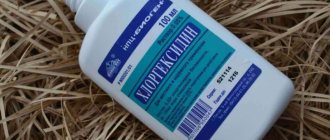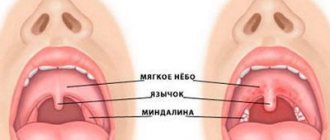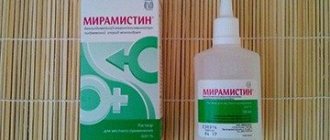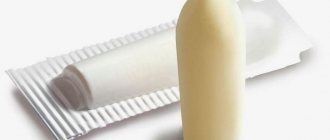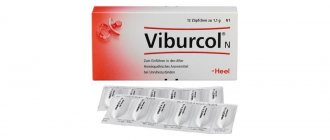There is a whole list of external and internal reasons why gum inflammation occurs. The first include:
- Lack of hygiene.
- Small wounds in the oral cavity.
- Dental plaque, tartar.
- Allergy to dentures or braces.
- Smoking.
As for internal reasons, they are as follows:
- Vitamin deficiency and problems with immunity.
- Genetic predisposition.
- Pathologies and chronic diseases.
- Pregnancy.
How does Miramistin work?
The therapeutic effect occurs due to the active substance, which acts on the membrane of pathogenic microorganisms.
The active component has an effect on bacterial membranes, reduces their permeability and promotes their dissolution. The drug has the following effects:
- activates the ciliated epithelium, as a result of which the surface of the throat is freed from infection;
- promotes the resorption of blood clots in blood vessels;
- when entering the bronchi, it promotes lipid oxidation;
- activates local immunity;
- increases the effectiveness of antibiotics;
- does not enter the general and systemic bloodstream and soft tissues.
The effect of the drug on infectious diseases of the throat and upper respiratory tract
For infections of the upper respiratory tract and throat, Miramistin can be used as a gargle, as well as a spray that is used to irrigate the surface of the throat.
For throat diseases, Miramistin reduces swelling, inflammation and destroys pathogens. Although the drug does not have analgesic properties, it helps reduce sore throat due to its anti-inflammatory effect. In addition, the drug enhances the activity of the ciliated epithelium, which helps eliminate infection and accelerates the restoration of damaged epithelium.
Treatment of throat and upper respiratory tract infections rarely resolves without the use of antibiotics. And here another property of Miramistin turns out to be useful - enhancing the effect of antibacterial drugs.
The drug is effective at any stage of infectious diseases - both at the very beginning of the pathological process and during the formation of pus.
When treating upper respiratory tract infections, it should be remembered that Miramistin is not a panacea. The product is effective only in combination with other drugs - anti-inflammatory drugs, herbal decoctions, antibiotics, etc.
Directions for use and doses
1st trimester
At the first stage of pregnancy, Miramistin can be used only as prescribed by a doctor. Only a specialist will be able to determine the ratio of the therapeutic effect to the side effects. Many gynecologists do not recommend using this drug in the 1st trimester. If necessary, you should limit yourself to those methods of use in which there is no risk of the drug getting into the blood.
- 10 ml for nasal rinsing;
- 10-15 ml for rinsing;
- 2-4 presses when using the spray to treat the throat and nose;
- 2-3 drops of solution for instillation into the nostrils;
- a strip of 0.5-1 cm of ointment for applying to wounds.
2nd trimester
At the second stage of pregnancy, you should also be careful when using Miramistin. The methods of use here are the same as for the first trimester. It is better to limit yourself to external methods of application in order to exclude the transfer of the drug through the blood to the placenta and the child. Do not exceed the dosages indicated above.
Kuzmenkova Liliya Olegovna
dentist, candidate of medical sciences, doctor of the highest category, member of the European Association of Maxillofacial Surgery, member of the Eurasian Association of Aesthetic Dentistry
- Irrigator type: stationary
- Water pressure: 70-620 kPa
- Tank volume: 1000 ml
- Number of attachments included: 4
- Operating modes: 5
- Irrigator type: portable
- Water pressure: 310-520 kPa
- Tank volume: 210 ml
- Number of attachments included: 4
- Operating modes: 2
- Irrigator type: stationary
- Water pressure: 70-690 kPa
- Tank volume: 650 ml
- Number of attachments included: 7
- Operating modes: 20
- For deep, gentle cleansing of gum pockets.
- Effectively massages the gums and reduces their bleeding.
- The soft silicone tip does not injure the gums.
- Recommended in the presence of orthopedic structures.
- For the care of deep gum pockets.
- Removes plaque in the gum pocket.
- Reduces gum bleeding.
- The soft silicone tip massages and does not injure the gums.
- Recommended for use in the presence of orthopedic structures.
- Irrigator type: stationary
- Water pressure: 70-690 kPa
- Tank volume: 650 ml
- Number of attachments included: 7
- Operating modes: 10
- Irrigator type: stationary
- Water pressure: 70-690 kPa
- Tank volume: 650 ml
- Number of attachments included: 7
- Operating modes: 10
It is possible, but only as prescribed by your doctor and in the dosage that will be prescribed by a specialist.
- Where can I buy
- Guarantees
- Shipping and payment
- Catalog
- About company
- Contacts
- Blog
- Video
- legal information
made in
Use of Miramistin during pregnancy
Currently, there are no extensive scientific studies on the use of Miramistin in pregnant women.
It should be noted that when the drug is applied topically (skin and mucous membranes), the active substance is not absorbed into the systemic circulation, i.e. it can be used in the treatment of purulent diseases of the skin and mucous membranes, such as pyoderma, fungal infections, damage to the ENT organs and respiratory tract (tonsillitis, sinusitis, laryngitis, etc.).
In these cases, the throat is gargled with Miramistin solution up to 6 times a day for 5-7 days; for skin diseases, the medicine is applied to the affected area (including under a bandage) for a period determined by the doctor.
However, its use for various gynecological or urological diseases (vulvovaginitis, endometriosis, urethritis) requires a certain amount of caution. The fact is that in such cases Miramistin is administered by douching - and this is unacceptable during pregnancy
How to rinse an inflamed gum, what medications will help with inflammation
It is first necessary to determine what is the cause of the swelling and redness, since this determines the choice of medicine.
All of them are divided into three categories, in accordance with the main effects they provide:
- Antiseptics and preparations containing antibiotics. They are designed to prevent the spread of bacterial infection. Most often prescribed by dentists for serious illnesses or after operations on the gums, including after nerve removal and wisdom teeth extraction.
- Anti-inflammatory. They are designed to relieve inflammation, reduce pain, eliminate swelling and redness.
- Solutions that combine the two above effects, that is, a combination of them. They are the most effective.
The best way out of the situation is to act according to the doctor’s instructions.
Only a qualified specialist can prescribe treatment that will not cause harm. But if your appointment is scheduled for the next day, you should use medications that definitely won’t hurt, but can have a positive effect on the dynamics of treatment and relieve the first signs. Below we present a list of them.
Chlorhexidine
This is an inexpensive drug that is effective in disinfecting the skin and mucous membranes. It can be used to treat not only scratches and abrasions, but also any wounds in the mouth, including after dental intervention. It kills bacteria well, however, it cannot protect against fungal or viral infections.
Rinsing with a solution with a concentration of 0.05% can be done 2 to 6 times a week. An important note: chlorhexidine cannot be used for a long time, since it, together with pathogenic bacteria, affects beneficial bacteria and washes away the microflora in the oral cavity.
Miramistin
Somewhat more expensive, although the effect can be called similar. The scope of application is much wider, because the medication not only kills the maximum number of pathogenic microorganisms, but also relieves inflammation and irritation of the mucous membranes.
It is also prescribed for stomatitis or herpes.
It is widespread because it is considered absolutely safe even if swallowed by pregnant women or children.
Stomatophyte
A concentrated product that must be diluted with water before use. It perfectly eliminates the inflammatory process, thanks to a large number of medicinal components of plant origin: chamomile, oak bark, arnica, etc. Rinsing is required for 10 days 2-4 times. But you need to be careful - the composition contains alcohol, so it is not recommended for children.
Tantum verde
Essentially, this is the same Chlorhexidine, but the solution contains much more active substance, the concentration of which is 0.15%. Therefore the price is slightly higher.
The medication should be used less frequently - 2 times a day, starting from 12 years of age. It has several effects:
- Relieving swelling.
- Anesthesia.
- Elimination of the bacterial focus.
When and how is it used?
One of the most common reasons to prescribe Miramistin is various skin lesions. The drug is used to treat burns, cuts, bedsores, abrasions and scratches. It is in great demand for suppuration of wounds, as well as for the prevention of such complications. In addition, Miramistin is used for dermatitis caused by bacteria or fungal flora. You usually need to apply the medication to the surface of the skin 2-3 times a day. The inflamed or damaged area is washed for 3-5 days or longer if necessary.
The drug is often prescribed by ENT doctors, as it can help in the treatment of pharyngitis, sinusitis, otitis media, adenoiditis, rhinitis and other diseases. All these pathologies can pose a danger to the development of the child and provoke various pregnancy complications, so the use of Miramistin for them is completely justified.
If the expectant mother has a sore throat or other throat disease, the doctor will recommend rinsing with 10-15 ml of solution or applying the drug using a spray nozzle, pressing it 3-4 times. This treatment is usually carried out 3-4 times a day for 5-10 days.
For a runny nose, the medication is dripped 2 drops into each nasal passage up to eight times a day; for otitis media, 2-3 drops are injected into the ear canals up to four times a day. Ophthalmologists also prescribe Miramistin drops for patients with conjunctivitis. If a pregnant woman develops such an unpleasant disease, the solution is used in each eye, 1-2 drops 3-6 times a day.
For infections of the oral cavity or damage to the oral mucosa, the solution is used for rinsing. It is used for periodontitis, stomatitis and gingivitis, including candidiasis. For one procedure, take 10-15 ml of the medicine, keep it in the mouth for some time, and then spit it out.
If a pregnant woman’s cold has turned into bronchitis, then in combination with other treatment she may be prescribed inhalations with Miramistin. Such procedures are done in a nebulizer. 4 milliliters of antiseptic is poured into his chamber (sometimes, on the advice of a doctor, it needs to be diluted with saline) and the drug is inhaled 3-4 times a day.
The expectant mother may also be prescribed douching with Miramistin for thrush, urethritis or vaginitis, if these diseases arose while expecting the baby.
This medicine is often used before childbirth to reduce the risk of infection. It is administered vaginally for several days before birth (usually 5-7 days), and during cervical dilation, the vagina is irrigated after each examination. If a woman is about to have a caesarean section, then Miramistin can be used during this operation - the solution is used to treat both the vagina and the uterine cavity, as well as all incisions.
Application of solution in dentistry
According to the classification, the drug belongs to cationic antiseptics. It not only has an anti-inflammatory and antimicrobial effect, but also improves immunity at the local level. When used in the mouth, macrophages and phagocytes that are beneficial and important for human health are activated. It is used to destroy:
- anaerobic bacteria;
- some fungi (in particular, yeast, dermatophytes and penicillin);
- many streptococci and staphylococci;
- herpes virus.
All these unpleasant microorganisms can cause complex diseases in the oral cavity. When they get into a wound on the gum, they provoke suppuration, a rash on the palate or the inner surfaces of the cheeks, under the tongue. Therefore, they can remove the consequences of stomatitis and painful candidiasis, and improve the condition of periodontal disease or periodontitis in children and adults.
For elderly patients, this antiseptic is indispensable if it is necessary to thoroughly clean dentures every day. The complex insert structure is not easy to thoroughly clean from food debris and plaque. This leads to irritation of soft tissues, the formation of wounds and ulcers. By using Miramistin daily for gums and rinsing implants, you can reduce the risk of such unpleasant complications.
How often do dentists use Miramistin?
Miramistin is used in dental practice not only to eliminate gum inflammation. The drug in the form of a spray or solution is used to treat stomatitis, gingivitis, periodontitis, periodontitis, as well as to prevent inflammation after dental treatment or surgery.
Miramistin can also be used to treat removable dentures; the drug is excellent for the treatment of candidiasis and other fungal diseases in adults and children.
- For stomatitis,
Miramistin is suitable both in the form of a spray and in the form of a rinse solution. The spray should be used 3 times a day for 7-10 days, spraying the drug onto the mucous membrane. You can rinse your mouth with Miramistin solution. - For herpetic stomatitis,
it is worth adding antiviral and immunostimulating agents to treatment and rinsing with Miramistin, after consultation with a specialist. - In case of simple inflammation of the gums
, to increase the effectiveness of treatment, rinsing with Miramistin should be supplemented with the removal of tartar.
Is Miramistin effective for stomatitis?
The drug has antimicrobial and bactericidal properties, destroying gram-negative and gram-positive microflora. Under the influence of Miramistin, the proliferation of fungi is inhibited, stopping the development of the disease. The medicine helps to form an adequate and correct immune response. As a result:
- local immunity significantly enhances its protective properties;
- the infection stops spreading to healthy tissue;
- already damaged tissues are restored faster;
- the drug helps to adsorb (collect) pus and remove waste products of pathogenic microorganisms;
- stops inflammatory processes.
Miramistin is available for sale in three forms: as a spray, solution and ointment. This helps the patient choose the most convenient option for using the drug.
A big advantage of the drug is its good compatibility with other antibiotics that are taken to increase tissue regeneration, as well as the taste of the drug. Many medications that are intended for treating the oral cavity are produced with an unpleasant taste. This becomes a problem when using them for children. Reflex vomiting and increased salivation can create a dangerous situation for the child’s health. Miramistin is distinguished by the absence of antipathetic odors and tastes. The solution is more similar in taste to plain water, which greatly simplifies the procedure for using it for children.
The drug is also suitable for preventive purposes when one of the family members already has the problem. To do this, the oral cavity is sprayed with Miramistin solution 2 times a day, but the drug cannot be used for more than 10 days.
The use of the drug does not always guarantee a positive result in treatment. Miramistin will not bring the expected result for allergic stomatitis. Treatment may fail if the disease is caused by dental problems. These include: the presence of periodontal disease or tartar, advanced caries, as well as the presence of other inflammatory processes. First you need to eliminate the original cause. Then just start fighting stomatitis.
Miramistin for gum inflammation
Miramistin is often used for gum inflammation, which manifests itself as a symptom of various dental ailments. The drug has proven itself in complex treatment, where it is used to rinse the mouth. To obtain the most positive result from the rinsing procedure, you need to properly prepare the gums and mucous membranes. This is done as follows:
- The oral cavity is thoroughly cleaned with conventional hygiene products (brush, dental floss and toothpaste). This will make it possible to eliminate plaque and food debris from all hard-to-reach places where the drug should subsequently reach.
- The drug will give a positive effect faster if you increase blood circulation. To do this, you should massage your gums. It is done using the thumb and index finger. The gums are massaged using massage movements for five minutes. For massage, you can use a paste containing medicinal herbs or a drop of essential oil.
- After the massage, the oral cavity is rinsed with water at room temperature (in cases where additional products were used).
Further, all rinsing procedures occur in the order prescribed by the doctor.
In dentistry, Miramistin is also used for the treatment of periodontitis, for hygienic procedures for removable dentures, and also as an effective means for the prevention of microbial complications that may arise after surgical interventions on the oral mucosa.
Gum diseases
Loose teeth, painful gums and bad breath are just some of the unpleasant symptoms of gum disease. The most common diseases are periodontal disease. periodontitis and gingivitis. the clinical picture of which allows them to be classified as one group of diseases.
Usually the reason for going to the dentist is toothache, but the almost painless chronic course that some diseases of the teeth and gums take only complicates the situation and can lead to the loss of healthy teeth.
This is why it is recommended to visit the dentist at least twice a year.
Gum diseases in children at an early age significantly affect the formation of permanent dentition. Thus, new teeth are embedded in the gums, which, even when they appear, can be affected by caries. These children require regular dental care.
With periodontitis, the gums become inflamed and lose their ability to hold the tooth in the jaw bed. Treatment of gums with periodontitis should be immediate - when the first signs of inflammation appear, you should consult a dentist.
This is interesting: Are X-rays harmful: dangerous effects on the human body, health consequences
The antiseptic drug Miramistin® will help reduce inflammation of the mucous membrane, prevent infection and fight gum disease.
Miramistin® has a wide spectrum of antimicrobial activity, which allows you to effectively fight bacteria, fungi and viruses that affect the mucous membrane. Thanks to this, the drug is used in pediatric dentistry in the treatment of stomatitis and other oral lesions of bacterial or fungal origin.
Thus, thanks to the special formula of the drug, treatment of gum diseases with Miramistin is effective for inflammatory diseases of various etiologies.
We suggest you read: The lower jaw hurts on the left and right when I open my mouth, I can’t yawn widely, there is pain in the upper jaw joint
To rinse, you need to put 15 ml of undiluted Miramistin in your mouth and start the procedure. When rinsing, it is important to ensure that the gums come into contact with the antiseptic. After rinsing, the drug should be spat out.
Doctors recommend repeating the procedure twice a day for 10 days until the inflammation is eliminated.
Miramistin is used in dental practice not only to eliminate gum inflammation. The drug in the form of a spray or solution is used to treat stomatitis, gingivitis, periodontitis, periodontitis, as well as to prevent inflammation after dental treatment or surgery.
Miramistin can also be used to treat removable dentures; the drug is excellent for the treatment of candidiasis and other fungal diseases in adults and children.
- For stomatitis, Miramistin is suitable both in the form of a spray and in the form of a rinse solution. The spray should be used 3 times a day for 7-10 days, spraying the drug onto the mucous membrane. You can rinse your mouth with Miramistin solution.
- For herpetic stomatitis, it is worth adding antiviral and immunostimulating agents to treatment and rinsing with Miramistin.
- In case of simple inflammation of the gums, to increase the effectiveness of treatment, rinsing with Miramistin should be supplemented with the removal of tartar.
The drug has virtually no contraindications, but Miramistin is not recommended for use for more than 10 days. Also, people with individual intolerance to the drug should not rinse their mouths with the solution. In very rare cases, Miramistin may cause an adverse reaction in the form of burning and allergies.
An effective alternative to Miramistin can be Asepta Active mouth rinse. This remedy combines a combination of anti-inflammatory, analgesic components, benzydamine and the antimicrobial component chlorhexidine.
This composition complements the antiseptic effect of the mouthwash by quickly relieving pain, which significantly increases the effectiveness and speed of treatment of gum inflammation.
Use for toothache
Often after tooth extraction, the doctor prescribes rinsing with various antiseptic solutions. The primary goal of this procedure is to prevent wound infection. But in addition to this, Miramistin has an anti-inflammatory effect, affecting the symptoms of the pathological process. One of the symptoms of inflammation is pain. The drug also saves from it.
Almost no one prescribes this remedy as a first-line fighter against toothache. In most cases, this is done to prevent the development of this unpleasant syndrome.
In what cases is rinsing with Miramistin prescribed:
- After the retraction. Tooth extraction can be performed against the background of an inflammatory process. The procedure may be complicated due to an inconvenient location in the hole or doctor errors. In such cases, to prevent the development of alveolitis, rinsing with this solution is prescribed. The course lasts up to 10 days, during which time you need to perform oral baths 2-3 times daily.
- In the treatment of gum or periodontal inflammation. Therapy for gingivitis and periodontitis should begin with eliminating the main causes and factors leading to their occurrence. To do this, professional hygiene is initially carried out, after which, ideally, you should give up smoking and other bad habits. Immediately after the procedures, the doctor prescribes a course of rinsing, which may include not only rinsing with the solution in question, but also applying another drug, Cholisal gel.
- In the treatment of stomatitis. Dentists note that this is one of the best remedies for this pathology. It quickly suppresses the activity of viruses, which leads to suppression of their condition and a gradual decline in the disease.
These are the most common oral applications. If the patient has any other indications, the doctor will definitely tell you about it and prescribe a course of this drug.
Contraindications
As written in the instructions for the medicine, Miramistin has no contraindications for pregnant women. The only thing you may encounter is an allergic reaction or individual intolerance to the medicine. To avoid an unpleasant situation, a small area of skin is pre-lubricated. If there are no changes on the skin within 20 minutes, then the product is safe. You can also consult a doctor before starting gargling or irrigation, who will take into account the characteristics of the patient. Prescribe a safe and effective medicine for the mother and her child.
Important Synecode cough syrup for children: instructions for use, reviews
Studies have been conducted that have identified only 3% of pregnant women susceptible to an allergic reaction. But usually the side effects are minor, and the course of treatment is continued. Sometimes, if the dosage is incorrect, the product can cause itching and burning, and in the case of inhalation, you can get a burn to the mucous membrane. In general, no overdose has been reported in pregnant women, so you can be calm about this.
Also, no mutagenic effects have been identified; the product is not absorbed into the placenta, therefore it is safe during pregnancy. It is not advisable to get the product into the eyes.
For what throat diseases in pregnant women is it prescribed, how does it affect the fetus?
In the official instructions for Miramistin, pregnancy is not listed as a contraindication. On the antiseptic website in the “Questions and Answers” section, the manufacturer’s specialist explains that the active substance does not enter the bloodstream during local treatment, does not have a negative effect on the fetus, practically does not cause allergies and does not irritate the mucous membranes. Based on this, the solution can be used throughout the gestational period. Long-term clinical experience also proves the safety of the antiseptic in question during pregnancy.
Miramistin is prescribed by doctors for the following throat ailments:
- tonsillitis;
- angina;
- pharyngitis;
- laryngitis.
Moreover, if you start using Miramistin immediately when there is redness, mild pain and a sore throat, then further development of the disease, as a rule, can be avoided. Otherwise, the drug has to be used in complex therapy. In this case, it is possible to reduce the severity of painful manifestations, prevent the possibility of complications and shorten the duration of the disease.
One of the indications for the use of Miramistin is tonsillitis - acute inflammation of the tonsils.
In what form to apply
The following methods can be used to treat the mucous membrane of the throat with Miramistin:
- rinsing;
- irrigation with a spray nozzle;
- inhalation.
Rinsing is considered more effective, as it simultaneously mechanically cleanses the surface of the tonsils from dead bacteria and their waste products. Rinsing is also indispensable when pus forms. The spray is convenient for those who are at work and on the street, in transport and in cafes. Typically, the spray is used to treat children who are not yet able to gargle. Inhalations are prescribed if inflammation has affected the lower respiratory tract.
Miramistin can be used by pregnant women as a prophylaxis after communicating with a carrier of the infection, in severe epidemiological conditions in the region of residence, or after hypothermia.
Instructions for use of the drug
The drug Miramistin is a medicine in liquid form and is used for topical use in adults.
This product is not used for children. Miramistin, instructions for use during pregnancy of which are presented below, is usually used in courses that range from 3 to 5 days, depending on the type and complexity of the problem:
- before childbirth, prophylaxis can be carried out for 3-5 days by spraying the birth canal;
- they also carry out the prevention of infectious diseases and suppuration by introducing a tampon soaked in a solution;
- when treating urological diseases, the drug is injected into the urethra, but only a doctor should do this;
- after a caesarean section, the birth canal is treated with a cotton swab for 5-7 days;
- skin lesions are treated by spraying 3-4 times throughout the day;
- if there are lacerations and burns, then bandages moistened with the drug are applied to the damaged surface;
- the oral cavity is treated with periodic rinses (3-4 times throughout the day);
- for purulent otitis, a tampon soaked in Miramistin is placed in the ear canal, the procedure is repeated 3-4 times a day for two weeks;
- for tonsillitis, laryngitis, pharyngitis, rinse the mouth 3-4 times a day.
Important! Despite the fact that a drug called Miramistin belongs to the category of safe drugs, this does not mean that it can be used without a doctor’s prescription. And even more so during pregnancy
Features of use
Miramistin must be spat out after treatment of the oral cavity, but in case of accidental ingestion, there is no need to worry.
People who have been diagnosed with a catarrhal form of gastritis, provoked precisely by an imbalance of the positive microflora of the gastrointestinal tract, should use the solution more carefully.
This is interesting: How can you cure tonsillitis at home?
During dental treatment of teeth, gums or oral mucosa, a burning sensation may occur - this is a normal reaction. You just have to remember that the drug should be used only for local treatment. Accordingly, if it is necessary to act exclusively on a small area of the gum, then it is better to use a tampon rather than completely rinse the oral cavity.
When performing retraction (putting a thread into the gum pocket), only cotton material is used. After removing it, you should not rinse your mouth with water.
Use by children and pregnant women
The age restrictions specified in the instructions are mainly aimed at the fact that children do not yet know how to rinse their mouths and therefore can swallow the product. If other means do not help and there is a need to use Miramistin for a small child, then you can use a spray or treat the affected areas with a piece of gauze soaked in the solution.
If the child has the skills to rinse the mouth, then you can give him 3-4 ml of the product, after diluting it with water in a ratio of 1:1.
According to the instructions, there are no contraindications for using an antiseptic during pregnancy or lactation. The drug does not penetrate into the blood, so it will not harm the fetus. But doctors recommend first testing for an allergic reaction. To do this, drop a small amount of solution onto the skin of the wrist, rub and wait 15-20 minutes. If there is no negative reaction (redness, blisters, rash), then you can rinse your mouth with Miramistin according to the instructions. This product should not be used as a douche during pregnancy.
Features of use for children
The neutral taste and light composition make it possible to use Miramistin for candidiasis even in children in the first years of life. The main problem is that children cannot rinse their mouths, so a special nozzle with a long spout can help parents. An adult opens the oral cavity with a small spoon and holds it in this position, while simultaneously quickly pressing on the lid.
During the procedure, it is necessary to avoid applying Mirimistin to the larynx and tonsils. This may cause a coughing fit or lead to cramping. If painful plaques and sores are found on the inner surface of the cheek, gums and under the tongue, a few drops of antiseptic are applied to a clean cotton swab. They wipe the inflamed areas with it, carefully blotting open wounds. Using a piece of gauze and medicine, you can remove the whitish film, slowing down the development of candida bacteria and improving the baby's condition.
Forms of release of the drug and composition
The drug is produced in the form of an ointment, liquid and spray with a spray nozzle.
Miramistin solution for topical use
colorless, transparent, foaming when shaken.
| Main active ingredient: | In 1 liter |
| benzyldimethyl ammonium chloride monohydrate | 100 mg. |
Excipients in the solution
: purified water – up to 1 liter.
The solution is available in bottles with different dosages:
- 50 ml with spray nozzle (travel form). Used to treat the mucous membranes of the mouth and skin during travel.
- 150 ml with spray nozzle. It is used to treat erosions in the oral cavity and treat open wounds.
- 50 ml with urological applicator. The drug is intended for the treatment of urological and gynecological diseases.
- 500ml. The economical form of the drug is suitable for manipulations that require the use of a large volume of medication, for example, for dressings or lotions.
Types of release forms of the drug Miramistin.
Miramistin-Darnitsa ointment for local and external use
0.5%.
| Main active ingredient: | In 100 gr. |
| miramistin (benzyldimethyl-myristoylamino-propylammonium chloride) | 500 mg. |
15, 20 and 30 gr. – aluminum tubes (1 piece) – cardboard packs.
100, 500 and 1000 gr. – polymer cans.
Clinical and pharmacological group of the drug: Antiseptic for local use.
Pharmacotherapeutic group of the drug: Antiseptic.
Can Miramistin be used by pregnant women?
To the question “Can Miramistin be used during pregnancy for a sore throat?”, pharmaceuticals give a positive answer. This drug is an antiseptic, the action of which is aimed at inhibiting viruses and bacteria on human mucous membranes.
Miramistin for pregnant women effectively fights almost all microorganisms that can cause infectious diseases; it can even resist viruses and microscopic fungi. It is necessary to use Miramistin during pregnancy for the throat in case of infectious diseases, for example: acute respiratory infections, sore throat, candidiasis, influenza.
Having a pronounced antiseptic effect, Miramistin for the throat during pregnancy does not have a toxic effect, so its use is allowed even for infants, pregnant and lactating women.
The drug is allowed to be used only externally, for treating mucous membranes. The substance used for its intended purpose does not enter the blood, and, therefore, the possibility of its penetration through the placenta is minimal. Therefore, it cannot have any effect on the growth and development of the baby, as well as on the state of pregnancy as a whole.
But you should take some precautions to avoid accidental ingestion of the medicine.
Miramistin during pregnancy. 1st trimester
It is possible to use Miramistin in the throat during pregnancy in the 1st trimester only as prescribed by a doctor. He himself must determine the ratio of the therapeutic effect for the mother and the possible side effect on the course of pregnancy.
This period is the most important for the health of the unborn child, since at this time the formation of all vital organs and systems in the human body occurs. Although the instructions for the medicine indicate the possibility of its use at any time, existing contraindications can have a negative effect on the fetus. Despite its high effectiveness, most gynecologists allow the use of this medicine only from the fourth month of gestation.
Miramistin during pregnancy 2nd trimester
Is it possible to spray the throat with Miramistin during pregnancy, starting from the 14th week of pregnancy? It is allowed to be used externally as an antiseptic drug. But drug manufacturers do not guarantee absolute safety. Therefore, it should be used only when it is really necessary.
Miramistin during pregnancy 3rd trimester
It is quite acceptable to use Miramistin during pregnancy for the throat in the form of a spray in the 3rd trimester, starting from the sixth month of pregnancy.
Moreover, this remedy is widely used by gynecologists to prevent possible infections after childbirth and cesarean section.
The instructions for Miramistin indicate that the solution is transparent in color, without taste or pungent odor, and does not cause discomfort when rinsing.
Rules for using Miramistin during pregnancy
There are separate rules for using the drug, taking into account the specifics of the disease.
Into the throat
To eliminate diseases, the product can be used as a rinse or inhalation. When rinsing, the patient needs to take 10 ml of the drug. The average duration of the procedure is 2-3 minutes.
Important Dry cough in a child without fever: frequent, constant, long, protracted, prolonged, why it happens at night, in infants, whether it needs treatment
The product must be used up to 4-5 times daily. Inhalations are rarely carried out, which is explained by the high likelihood of developing allergic reactions. Add 5 ml of product to the nebulizer container.
Into the nose
Instillation into the nose is possible only after consultation with a specialist. In this case, the drug can not only have an antiseptic effect for a runny nose, but also prevent the spread of infection to other parts. Due to its irritating effect on the mucous membrane, the use of this product is limited.
For otitis media
For the treatment of otitis, Miramistin can be used for catarrhal and purulent forms.
The product is instilled into the ear canal, heated to a comfortable temperature, 1 ml of solution. Instillations are made three times per day for 7-10 days.
Inhalations
Inhalations are rarely carried out, as there is a high probability of developing an allergic reaction. Add 5 ml of product to the nebulizer container.
Method of administration and dosage of the drug
The method of using Miramistin solution and ointment for pregnant women and the dosage depends on the type of pathology:
- For disinfection of wounds, lotions with the drug (0.01%). To restore the skin after burns, occlusive dressings soaked generously in an antibacterial solution are used.
- For therapy after osteomyelitis. Miramistin solution is injected into the wound through drainage or through gauze swabs. Manipulations are performed 2-3 times a day for a week. During therapy, up to 1 liter of the drug may be needed.
- For the treatment of purulent wounds. Turundacs with ointment are prescribed. The dose of the drug depends on the area of skin damage. Bandages with ointment are changed 2 times a day until the wound is regenerated.
- For the prevention of postpartum infectious pathologies. The genitals are treated using a spray nozzle a week before birth.
- For the treatment of mucous membranes of the genital organs that have undergone an infectious process. Swabs soaked in Miramistin are applied to the affected areas.
- For the treatment of genitourinary pathologies. The solution is injected into the urethra for 1-2 weeks.
- For the treatment of infectious diseases of the ENT organs. You can gargle with Miramistin during pregnancy or spray the solution on the mucous membranes.
Treatment of the throat during pregnancy
The drug Miramistin is used to treat ENT organs that have undergone an inflammatory process. Gargling with Miramistin during pregnancy (2nd and 3rd trimester) is allowed for sore throat, pharyngitis, tonsillitis and sore throat. You can treat the affected areas of the mucosa using a spray or solution.
The irrigation procedure does not raise any questions for patients. However, not everyone knows how to gargle with Miramistin. One rinse requires up to 15 ml of the drug
It is important to ensure that the medicine does not enter the stomach. After the procedure, it is not recommended to drink or eat food for 30 minutes
If there is a need for more frequent rinsing of the throat, then the drug is alternated with other anti-inflammatory non-drug drugs. Miramistin for the throat during pregnancy can be combined with gargling with herbal infusions (chamomile, sage, calendula)
When using the drug to irrigate the mucous membranes of the throat, you must first install the spray nozzle on the bottle. One click on the device is enough for processing. It is recommended to hold your breath during the procedure. During pregnancy, Miramistin is sprayed into the throat up to 6 times a day.
There are different types of throat diseases, and sometimes only a doctor can make an accurate diagnosis and prescribe a medicine that is safe for pregnancy.
Treatment of runny nose during pregnancy
Miramistin can be used during pregnancy to treat a runny nose. During illness, the drug is instilled a few drops into the nose 2 times a day.
Another option for using the medicine is rinsing the nasal sinuses with saline solutions, followed by treatment with Miramistin, produced in the form of a gel. To do this, lubricate a cotton swab in the product and treat the nasal mucosa. Miramistin can be used during pregnancy in the 1st trimester for no more than 3-5 days.
The drug solution is used for the treatment of purulent sinusitis during gestation. The procedure is performed in a hospital setting with the permission of a doctor. After the puncture, the nasal sinuses are washed with a large amount of antiseptic to remove necrotic masses and disinfect the surface of the mucous membranes.
Miramistin for runny nose during pregnancy is prescribed very often. At the same time, the drug is effective in the treatment and prevention of infectious diseases and damage to the immune system.
Getting rid of thrush
Weakened immunity during pregnancy causes the development of thrush. The description of the drug states that Miramistin can be used to treat the genitals in the first trimester of pregnancy and in later stages of gestation (in the second, third trimester).
Important! Genital douching cannot be performed at home. Incorrect insertion of the spray nozzle leads to injury to the amniotic membranes and mucous membranes, resulting in an increased risk of infection of the fetus
It is permissible to independently apply the ointment to the external damaged surfaces of the genital organs.
Recommendations from experts
If you find that your gums are bleeding, you should immediately visit a dentist. Only in this case can serious complications and constant relapses be avoided. The specialist will establish an accurate diagnosis and prescribe effective treatment.
Only experienced specialists take Cerekon in dentistry. Here you will be helped to get rid of bleeding gums quickly and painlessly. The clinic has the latest equipment for accurate diagnosis and high-quality treatment of any dental and periodontal diseases. We offer each patient comfortable treatment conditions and guarantee a positive result.
Remember that it is not always possible to cope with bleeding at home. Sometimes we are talking about more serious diagnoses that require urgent medical intervention. As soon as you encounter this problem, do not delay your visit to the doctor.
Features of treatment
A Miramistin-based rinse is prescribed if the tonsils or oral mucosa are inflamed. As a standard, rinsing with miramistin is used 4-6 times a day. For a single rinse, use 10-15 ml of medication. It is not recommended to eat for half an hour after the procedure.
If you are prescribed more gargles than 6 times a day, then it is recommended to alternate Miramistin with other traditional solutions that are approved by your doctor. Can be used in the following rinses:
- chamomile;
- water with soda;
- infusion with raspberries, calendula or linden;
- furatsilin;
- sea water.
Miramistin in spray form is more convenient.
Gargling is not the only way to get rid of a sore throat; this procedure is replaced with a spray. Used with the same frequency as the rinse solution. 2-4 presses are enough to irrigate the tonsils. After the spray, there is a burning sensation in the throat for 15-20 minutes, this is normal.
Side effects when using this medicine are extremely rare. But itching, burning, swelling, and redness are still possible. If such symptoms appear, you need to stop the course of treatment with the drug and urgently consult a doctor.
How to rinse your mouth after removing a wisdom tooth or any other tooth?
So, if you have had a tooth pulled out, what to rinse your mouth with when necessary is the first question. Today, pharmacies have a wide range of specialized antiseptics, while at the same time there are many time-tested folk remedies. Let's consider what you can rinse a tooth with after extraction, and what is strictly prohibited.
Among the solutions produced industrially, in the situation under consideration it is recommended to use:
- Chlorhexidine. Using this product as an example, here is a detailed description of the rinsing procedure: Before rinsing your mouth with chlorhexidine after tooth extraction,
you need to rinse it with warm boiled water: take water into your mouth, hold it and carefully spit it out. - Then put 15-20 ml of solution into your mouth, hold it for 15-30 seconds, and spit. This action should be repeated several times./li>
All of the following solutions should be used in the same way.
- Miramistin;
- Tantum Verde.
In conclusion, we present those means that it is highly not recommended to treat the wound surface of the hole:
- Ethyl alcohol and products containing it;
- Hydrogen peroxide;
- Zelenka or iodine.
Contraindications and side effects
Miramistin should not be used by persons sensitive to its active substance. In all other cases, the drug can be used as prescribed by a specialist. The solution is not used in pediatrics, since its effect on children has not been sufficiently studied.
Any medicine has some side effects. When using Miramistin, pregnant women need to be prepared for some of their manifestations. The use of the drug may be accompanied by:
- a slight burning sensation in the throat (when gargling);
- allergic reactions when applying ointment to the skin.
Such effects are observed very rarely and are absolutely safe for pregnant women.
Therefore, the drug can be used at any stage of pregnancy.
Even if such reactions occur, they go away on their own within 20-30 seconds. Women expecting a baby have a physiologically reduced immune system, so reactions may persist for a longer time. In this case, you need to wait (up to 20 minutes), then consult a doctor. But such reactions usually pass without leaving a trace after a while and are safe for mother and baby.
Injections into the nasal cavity
This method is used for rhinitis and sinusitis. It is recommended to first clean the nasal cavity using saline solutions. Then a spray nozzle is inserted into the nasal passage and sprayed with 3-4 presses. The same operation is repeated in the other nasal passage. It is recommended to carry out a similar procedure 3-4 times a day. The course of treatment is 2 weeks.
Children under 3 years of age should not be irrigated with the drug into the nasal passages. They are recommended to instill 1 drop into each nasal passage 3 times a day. The course of treatment is 5-7 days. However, nasal irrigation is not prohibited for children over 3 years of age. The dosages are as follows:
- 3-6 years – 1 click,
- 7-14 years – 2 clicks,
- over 14 years old – 3 clicks.
Important Dioxidin: composition, review of instructions and reviews on the use of the medicine, analogues of the drug, indications, treatment for sinusitis, sore throat, how to store the medicine
The procedure is carried out 3-4 times a day. The course of treatment is 5-10 days.
How to rinse your mouth with Miramistin: features of successful therapy
There are a large number of different types of microorganisms in the external environment. Some of them have no effect on the human body, others cause many diseases. Innovative drugs are being created to combat them. One of these was Miramistin, which is widely used in various fields of medicine for therapeutic and prophylactic purposes.
How to use Miramistin for mouth rinse
Before starting to use an antibacterial agent, you must carefully study the instructions to determine the required dosage.
When using Miramistin for rinsing the mouth, the following rules should be observed:
- Mix 10-15 ml with warm boiled water in a 1:1 ratio.
- Before rinsing, hygienically brush your teeth and rinse your mouth to remove any remaining food.
- Rinse your mouth for 2-3 minutes, tilting your head back slightly.
- Do not allow the medicine to penetrate the nasal passages and do not swallow the medicine.
- Do not eat or drink for 1-1.5 hours after the procedure.
- Rinse your mouth 3-4 times a day.
You can treat inflamed gums using a tampon soaked in the solution. Wounds after tooth extraction are treated with bandage compresses, but only after the blood clot has hardened.
If a spray is used, then before use it is necessary to remove the cap from the spray nozzle and screw the nozzle to the bottle. To activate the nozzle, press the sprayer, after which the product is ready for use.
Sometimes after using the product you may experience a burning sensation. Usually this does not have any consequences and goes away on its own.
For acute tonsillitis and pharyngitis, irrigate the oral cavity 3-4 times a day. The dosage depends on the age of the child: for children 3-6 years old, it is enough to press the sprayer once, for children 7-14 years old, it is necessary to press it twice. The course of treatment lasts 4-10 days.
By following the rules for using Miramistin and alternating it with other antibacterial agents, you can quickly get rid of the disease. But before starting treatment, you must consult your doctor.
Use of Miramistin during pregnancy
Can this drug be used during pregnancy? This is a very pressing question that interests many expectant mothers to whom the doctor has prescribed this remedy. Every woman understands that a doctor does not prescribe any drug without a good reason. During pregnancy, hormonal changes occur in the body. This leads to the appearance of inflammatory and infectious diseases. Miramistin is a drug that can cure such ailments, while it is an excellent prophylactic agent.
The instructions for use indicate that Miramistin has no contraindications for its use during pregnancy. The only contraindication is a ban on douching. This drug treats sexually transmitted infections, as well as diseases associated with the nose and throat.
Instructions for use indicate a complete description of such a drug during pregnancy:
- Miramistin is prescribed for the treatment of suppurations, wounds and genital infections that occur after childbirth or surgery. Its effectiveness is manifested against thrush and other inflammatory processes of the female genital organs.
- The drug is used in obstetrics and gynecology, otolaryngology, dermatology, urology, dentistry, surgery and other areas of medicine.
- According to the instructions, the drug is applied to infected and inflamed surfaces 2 – 3 times a day. If it is used in gynecology, it is prescribed for the treatment of sexually transmitted infections and as preventive measures for the development of inflammation in the postpartum period.
Miramistin during pregnancy in the throat and nose
As the instructions for use indicate, Miramistin in the nose during pregnancy is prescribed for the treatment of ENT organs and runny nose. It is used for both local and external use. The drug is effective against aerobic, anaerobic bacteria and microbes. The peculiarity of the medicine is that it leads to the activation of regeneration processes. In otolaryngology, it is used for the complex treatment of acute and chronic forms of otitis, rhinitis, sinusitis, laryngitis and tonsillitis.
- laryngitis;
- tonsillitis;
- tonsillitis.
For convenience, Miramistin for the throat is available in the form of a spray and solution. The spray does not enter the body, but is able to have a therapeutic effect while on the surface of the mucous membrane of the throat. The therapeutic effect is achieved due to the fact that this remedy produces substances that begin to destroy pathogenic microbes. Miramistin has this effect both in the treatment of the throat and in the treatment of nasal diseases.
Miramistin for mouth rinse - how and when to use
Pharmacologists have created many drugs to combat pathogenic microorganisms. One of these drugs actively used in medicine is Miramistin. Getting to know this drug will help you find out in what cases it should be used and how to properly use Miramistin for mouth rinsing.
Development history
Initially, if you delve into the history of the creation of the product, it was planned for astronauts to make it possible to treat wounds and surfaces of equipment located in outer space. In such closed conditions, an ideal environment is created, suitable for the development of pathogenic microflora. To defeat these microorganisms, a truly effective remedy was required, which Miramistin turned out to be.
Today, thanks to the participation of private investors, the product has become available to everyone. It is available in almost every pharmacy and is available without a prescription.
General description of Miramistin
For the first time, the solution was proposed as a cosmetic product for the needs of the beauty industry. It was developed in the 80s as a universal drug that can quickly and completely destroy various types of harmful microorganisms, bacteria and fungal spores. Its properties were tested on the space station, where employees needed a new way to easily and safely disinfect in limited conditions.
Miramistin solution is a universal remedy that is widely used in medicine for the following purposes:
- treatment of open wounds and sutures during dressing after complex operations in surgery and traumatology;
- complex treatment of mycoses, acne or allergic skin rashes in dermatology;
- elimination of the consequences of purulent tonsillitis, laryngitis and tonsillitis, therapy of ear otitis;
- addition to the main treatment in venereology to reduce the activity of chlamydia and other dangerous pathogens;
- ensuring sterility during obstetrics, surgical operations, preventing complications from bedsores and open fractures.
In dentistry, Miramistin solution is used to treat many inflammations: gingivitis, various types of stomatitis or candidiasis. They can be used to treat open wounds after opening an abscess, fistula passages and even removable dentures. This is a new generation antiseptic that resists particularly persistent pathogens causing syphilis, HIV and ureoplasmosis.
Release form
Miramistin is now available in the following forms:
- solution for external use 0.01%;
- ointment 0.5% with the addition of disodium salt of edetic acid.
The solution is produced in plastic tubes with a capacity of 50, 100, 150, 200, 500 milliliters with a screw-on applicator (for use as a spray). Directly in dentistry, it is recommended to use a solution to prepare a rinse with an antiseptic effect.
Composition of the drug and pharmacological action
The Russian pharmaceutical company Infamed LLC is the manufacturer of Miramistin and produces it in liquid form, in the form of ointments and suppositories. For rinsing the mouth, use a solution with a concentration of 0.01%, packaged in plastic containers with a volume of 50, 100, 150, 200, 500 ml. The solution comes with a special nozzle in the form of a sprayer.
The active component of Miramistin is benzyldimethyl ammonium chloride monohydrate. The product also contains distilled water. The colorless, transparent solution has no odor or taste; only when the bottle is shaken, a light foam appears.
The antiseptic solution does not penetrate the bloodstream and does not interfere with the functioning of the body as a whole and individual organs. The main substance of the drug suppresses E. coli, salmonella, pneumococci, gonococcal infection and other bacteria and microbes. The drug activates the body's protective functions and promotes rapid regeneration of affected areas.
In order not to confuse an applicator intended for the genitals with a product for treating the oral cavity, when purchasing, you need to inform the pharmacist about the purpose of the purchase.
Scope of use and indications for use
The medicinal properties of Miramistin allow its use in various fields of medicine:
- in dentistry - for the treatment of many dental pathologies;
- in ENT practice – in the treatment of otolaryngological pathologies;
- in urology – for carrying out anti-inflammatory measures for diseases of the urethra;
- in venereology – for the prevention of sexually transmitted diseases and in the treatment of fungal pathologies;
- in gynecology – for postoperative preventive measures;
- in surgery – for the treatment of purulent wounds.
It is recommended to use Miramistin as a preventive measure during an epidemic of respiratory and viral infections. Gargling with an antiseptic helps eliminate sore throat, reduces swelling of the mucous membrane, and destroys pathogens.
Dentists prescribe Miramistin as a mouth rinse for gingivitis, periodontal disease, herpetic stomatitis, and fungal diseases of the oral cavity. Disinfection with an antiseptic is recommended after tooth extraction, especially if there is a process of suppuration. The drug cleanses the oral cavity of microorganisms, thereby reducing the inflammatory process. As a result, the hole hurts less, heals faster and the patient’s well-being improves.
Dentures are treated with an antiseptic. An ENT doctor prescribes rinsing with Miramistin for sore throat, pharyngitis, tonsillitis, sinusitis, acute otitis media.
Contraindications and side effects
Miramistin solution has virtually no negative effects. In individual cases, a local allergic reaction occurs in the form of a rash or redness of the skin, irritation of the oral mucosa. In the first seconds, a slight burning sensation may appear, which quickly passes when the antiseptic is absorbed.
The only contraindication is intolerance to the active ingredient. Therefore, it is used to treat dental infections in pregnant women at any stage. If discomfort and itching is observed, the antiseptic is replaced with Chlorhexidine or its analogues.
Pros and cons of the drug
Miramistin is rightfully the most popular, well-known and recommended antiseptic for external treatment and mouth rinse, which is explained by the following advantages:
- High antimicrobial activity - the product neutralizes gram-negative, gram-positive, anaerobic, aerobic microorganisms, including those that are resistant to antibiotics. It is most effective for infections caused by staphylococci, streptococci, trichomanas, chlamydia, spirochetes, Candida fungi, and herpes virus.
- The ability of the drug to accelerate tissue regeneration due to the formation of a protective film on the surface, disinfection, prevention of re-infection and drying of the wound surface.
- Versatility - the composition allows you to use the product not only as a mouth rinse, but also as a disinfectant solution for removable dentures;
- Can be used during pregnancy and for treating children.
- Various bottle sizes.
- Economical consumption thanks to the spray nozzle.
- Minimal side effects and contraindications.
This is interesting: Dental drill: purpose, types and design features
Thus, Miramistin can be used by patients of all ages, using a means for rinsing or irrigating the oral cavity for stomatitis, gingivitis, periodontitis, candidiasis, herpes, as well as after tooth extraction and when wearing removable prostheses. The composition is suitable for children, the drug is not prohibited during pregnancy and breastfeeding. For children who do not yet know how to rinse their mouth, a convenient spray nozzle is provided, which greatly facilitates the use of the drug.
The disadvantages include the relatively high cost of the drug and limitations in the duration of the course of treatment - long-term use (more than 10 days) can disrupt the microflora in the oral cavity and cause irritation such as allergic reactions.
Miramistin in the treatment of thrush in pregnant women
Hormonal changes, as well as activation of opportunistic flora, lead to the appearance of transient dysbacteriosis or vaginal mycosis in pregnant women.
Despite the prevalence of this phenomenon, one should not ignore the real harm that vaginal dysbiosis causes to the health of the mother and child:
- the risk of spontaneous abortion and prematurity increases. Against the background of frequent dysbiosis, hypoxia in newborns is often observed;
- the likelihood of developing abnormalities in the baby’s nervous system increases;
- There are real risks of ascending urinary tract infections.
Miramistin is often prescribed to pregnant women
Standard therapy for thrush involves local and systemic antibiotics, fungicides, and antiviral drugs, which are not recommended for pregnant women.
Miramistin destroys bacteria, fungi and even viruses, which makes it an indispensable local drug for the treatment of thrush in pregnant and lactating women.
The risk to the body of a woman and child is minimal, and if we compare the health risks caused by dysbiosis, the doctor’s choice almost always leans in favor of the drug.
Mixed infection, i.e. a combination of several pathogens is not an obstacle for Miramistin. Acts on a combination of extracellular and intracellular pathogens, a number of specific viruses, including HIV (locally, i.e. prevents penetration into tissues).
Miramistin for the prevention of infection of a newborn during passage through the birth canal
If you have an exacerbation of one of the chronic pelvic diseases, accompanied by thrush, Miramistin is an excellent remedy not only for stopping the exacerbation, but also for protecting the child from infection.
As a rule, to prevent the baby from infecting the baby with genital herpes, bacterial or fungal infections, 5-7 days before birth, irrigation or tamponade of the vaginal walls with miramistin is indicated. In addition, the external genitalia are treated with a solution of the drug.
Features of treatment with Miramistin
If necessary, the treating specialist prescribes Miramistin as an antiseptic for irrigation or rinsing of the affected membranes. Rinsing is prescribed in case of inflammation of the tonsils or pharynx area. Traditionally, therapy is maintained, which involves rinsing with Miramistin 4-6 times per day.
If it is necessary to gargle more than 6 times a day, it is recommended to alternate Miramistin with any other traditional gargling solutions that do not contain medicinal inclusions, unless otherwise indicated by a doctor. These include:
- chamomile infusions;
- solutions of soda and salt;
- tinctures based on calendula, raspberry or linden;
- furatsilin solutions;
- sea water.
After spraying, a burning sensation may be felt in the mouth - this is normal for Miramistin if the unpleasant symptoms disappear after 15-20 seconds.
Any side effects associated with the use of Miramistin occur extremely rarely. In exceptional situations, allergy symptoms are noted in the form of itching, dryness, prolonged burning, redness, swelling, etc. If you detect any kind of unwanted reactions from the body, stop using the drug and be sure to consult a doctor.
What is better Miramistin or Hydrogen Peroxide
Hydrogen peroxide is a non-toxic antiseptic solution. When irrigating tissues, the medicine prevents infection from entering the wound and prevents harmful microorganisms from entering the blood.
This inexpensive analogue of Miramistin can replace an expensive medicine. “Hydrogen peroxide” is used to gargle, irrigate wounds, scratches, and ulcers. Medical instruments can be treated with the solution. The antiseptic does not damage the layers of the epidermis and does not cause redness or burning. The medicine has been used in all hospitals for a long time.
When choosing “Hydrogen Peroxide” or “Miramistin”, you must take into account the purpose of use. When eliminating a sore throat, you can use “Hydrogen Peroxide” (to treat a sore throat).
A powerful antiseptic agent has a low price and is available to anyone. “Hydrogen peroxide” may well replace the expensive “Miramistin” in the treatment of a wide variety of diseases and injuries. The generic eliminates harmful microflora and disinfects the affected area, has an anti-inflammatory effect and disinfects well.
Sources:
- https://doverie-stomatolog93.ru/lechenie/miramistin-ot-zubnoj-boli.html
- https://zubki2.ru/gigiena-polosti-rta/miramistin-v-stomatologii-kak-primenyat.html
- https://zubsite.ru/gigiena-polosti-rta/miramistin-primenenie.html
- https://asepta.ru/spravochnik/desni/miramistin-pri-vospalenii-desen/
- https://CreateSmile.ru/miramistin-pri-stomatite/
- https://denta-da.ru/miramistin-pomogaet-zubnoy-boli/
- https://infodent.club/miramistin-pri-zubnoi-boli/
- https://felicita-stom.ru/boli/miramistin-ot-zubnoj-boli.html
- https://32zuba.guru/zubnaya-bol/chem-snyat/poloskat/
- https://kcdc.ru/preparaty/miramistin-sprej-dlya-gorla-detyam.html
Directions for use and doses
The method of application and dose of miramistin depend on the disease being treated and its symptoms. Let's look at the methods of use and dosage of miramistin in the treatment of the main indications for its use.
- If Miramistin is prescribed for disinfection of wounds, then a gauze bandage soaked in a 0.01% solution of the drug is applied to the affected area. When treating burns, an occlusive dressing is applied to the wound, which is generously moistened in a solution of the drug.
- When using the drug for osteomyelitis in the postoperative period, Miramistin is injected into the wound and fistula tracts through drainage or using gauze swabs. The procedures are carried out 3 times a day, for 5-7 days. Drainage of cavities and wounds using about one liter of miramistin solution per day shows high efficiency.
- When using an ointment, the drug is applied to the wound and a sterile bandage is applied. When treating purulent wounds and fistulas, gauze turundas with ointment are used. The dose of miramistin depends on the volume of affected tissue. The ointment is used 2 times a day until the desired therapeutic effect is obtained.
- To prevent postpartum infections, vaginal irrigation is used 5-7 days before childbirth and during the postpartum period.
- If Miramistin is used to treat lesions of the genital organs, use tampons that are soaked in miramistin solution. Electrophoresis is also possible for two weeks.
- For complex treatment of urethritis, 2-5 ml of the drug solution is injected into the urethra twice a day for 7-10 days.
- In the treatment of purulent sinusitis, Miramistin is used for puncture of the maxillary sinus. Gargling with a solution of the drug is also considered effective. To treat purulent otitis media, the drug is injected into the external auditory canal.
[], [], [], []
Miramistin during pregnancy in the 1st trimester
Miramistin during pregnancy in the 1st trimester can only be used with the permission of a doctor. Despite the fact that the drug's instructions allow it to be used during pregnancy at any stage, the drug has contraindications that can negatively affect the development of the child. Do not forget that not a single drug provides a 100% guarantee of absolute benefit and harmlessness. This suggests that miramistin, while providing a therapeutic effect for the mother, can cause minimal harm to her unborn child.
What else can you use?
An effective alternative to Miramistin can be Asepta Active mouth rinse. This remedy combines a combination of anti-inflammatory, analgesic components, benzydamine and the antimicrobial component chlorhexidine.
This composition complements the antiseptic effect of the mouthwash by quickly relieving pain, which significantly increases the effectiveness and speed of treatment of gum inflammation.
Chlorhexidine
A 0.05% aqueous solution is used to rinse the mouth .
Directions for use: take 1 tablespoon of the product into your mouth, rinse for 1 minute 2 times a day (preferably morning and evening), about one hour before brushing your teeth.
Treatment time is no more than 10 - 12 days. The medicine is not diluted. You need to rinse continuously for a minute.
An excellent remedy that has high antimicrobial activity and copes well with painful sensations.
When can you rinse with Novocaine?
For pain relief, a medicinal solution is used with a percentage of anesthetic from 0.25% to 2% in ampoules or bottles.
To prepare a rinse solution you need to take 200 ml of novocaine, the white of one egg, 1 teaspoon of salt. Mix everything. The resulting mixture must be kept in the mouth, in the place of discomfort. Repeat several times until the pain goes away.
Important! Under no circumstances should you swallow the solution.
Novocaine has a weak analgesic effect. It has a slight effect on inflammatory processes in tissues. Very toxic and causes allergies.
How to take other medications: Furacilin, Chlorophyllipit
Furacilin is a ready-made solution for rinsing based on sodium chloride, the concentration of which 0,002 %.
Use the product up to 5 times a day. Hold in mouth for 2 - 3 minutes , then spit out. The composition can be used for up to 10 days.
Before starting the procedure, you should rinse your mouth with soda solution to achieve the best effect.
Furacilin is an excellent antiseptic with a slight analgesic effect.
Chlorophyllipt is an antimicrobial agent based on natural eucalyptus.
A diluted alcohol solution is usually used to irrigate the oral cavity. The product is not used in its pure form, since there is a risk of burns on the mucous membrane.
Important! The drug should be taken with great caution, as its action causes an allergic reaction.
Chlorophyllipt has a mild effect on pain.
Rotokan
Rotokan is an alcohol tincture consisting of medicinal plants: calendula, chamomile and yarrow.
dissolve a teaspoon ( 5 ml in 1 glass (200 ml) of warm water. Rinse for 2 - 3 minutes, several times a day. The course of treatment is from 2 to 5 days.
Important! Do not use alcohol tincture undiluted.
Rotokan is quite suitable for pain relief and disinfection.
Stomatophyte
Stomatophyte is an anti-inflammatory agent, a liquid extract consisting of 7 different medicinal plants.
Photo 1. The drug Stomatofit in a 50 ml bottle is an anti-inflammatory agent for the oral cavity, consisting of seven medicinal plants.
The rinse solution is prepared as follows: 7.5 ml of extract is diluted in 1/4 cup of warm water. The procedure is carried out several times. The course of treatment is about two weeks . Repeated treatment is possible only as prescribed by the dentist.
Stomatophyte is a good medicine, but its anti-inflammatory effect is insignificant, so the relief of pain is weak.
